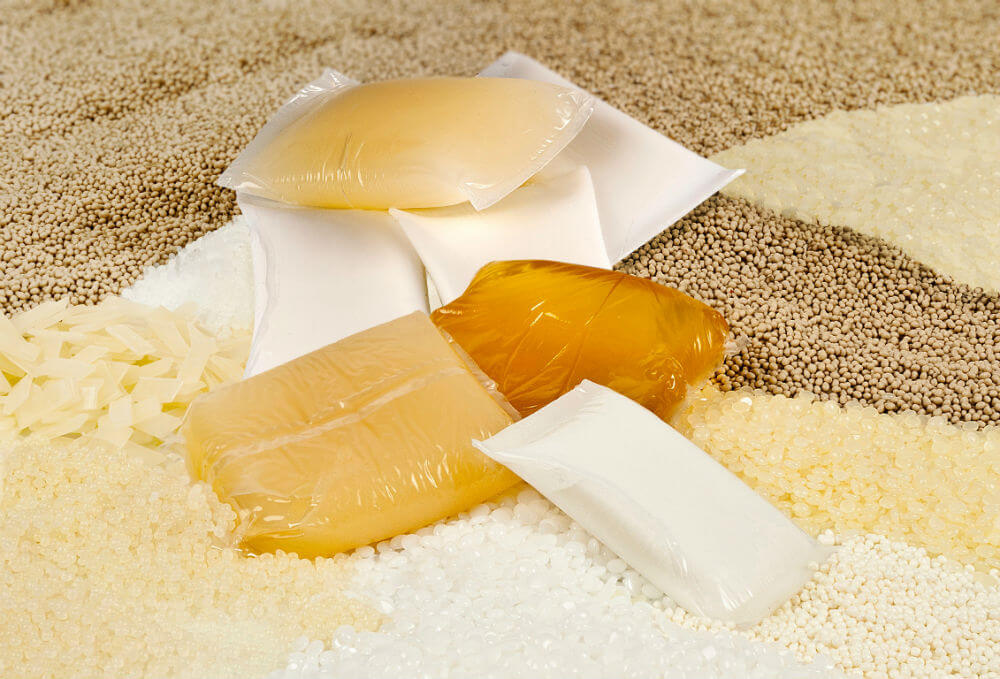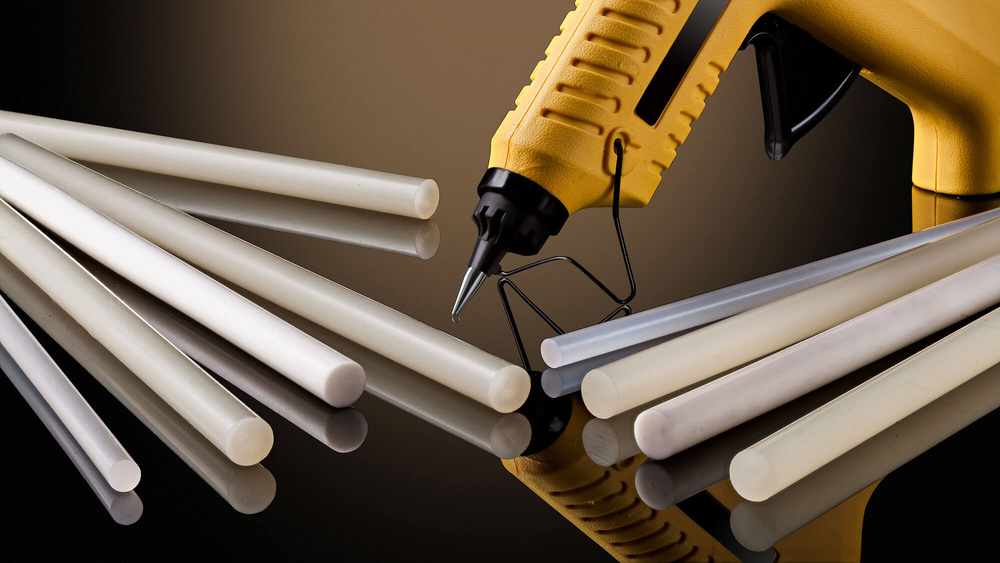Hot melt adhesive: properties and applications
- Types of hot melt adhesives depending on their composition
- Characteristic properties of hot melt adhesives
- How is a hot melt adhesive applied onto a surface?
- What hot melt adhesive to choose?
- Advantages of ВАМ hot melt adhesive
- Hot melt adhesive application areas
- Recommendations for using hot melt adhesives
- Where to buy hot melt adhesives in Ukraine
Hot melt adhesive (hot glue) is an adhesive produced based on hot melt polymers and resins. A hot melt adhesive preserves its solid structure at room temperatures and changes it when heated higher than the softening point. A hot melt adhesive is applied in the melted state at temperatures within 110-210 °С depending on the specific application and materials to be bonded. As soon as the adhesive cools, the adhesive joint becomes solid to bond the parts with each other.
The hot melt adhesive is loaded into a special hot melt adhesive station where it is melted under the effect of temperature and applied onto a surface with the help of injectors, nozzles or rollers.

Types of hot melt adhesives depending on their composition
The polymers making up the hot melt adhesive base impart required physical properties to the adhesive. The presence of additional components in the composition affects the adhesion and other hot melt adhesive characteristics.
The majority of hot melt adhesives are produced based on ethyl vinyl acetate (EVA). The adhesives are produced in the form of granules, tablets, blocks or adhesive sticks (rods). The external form of an adhesive is developed with account of specific applications and the design of the gluing unit. Hot melt adhesives in the form of rods (sticks) are used at both industrial enterprises and at home, and they are applied with the help of a hot glue gun.
Hot melt adhesives based on polyolefins are known as “clean” glues because they do not contain filling agents that leave a deposit on the equipment. Adhesives with the “self-cleaning” effect are low and economical in consumption, they set fast, are elastic, and the glue joint is resistant to a wide range of temperatures. Polyolefin adhesives are used in packaging, printing, woodworking, and in other branches of industry.
Polyurethane-based hot melt adhesives create a high-strength adhesive bond and they are used effectively in bookbinding and furniture making.
Hot melt pressure-sensitive adhesives (PSA) keep their tackiness properties after cooling and they are characterised by increased resistance to humidity levels and temperature variations. These adhesives are used for making scotch tapes and duct tape.

Characteristic properties of hot melt adhesives
When working with a hot melt adhesive we recommend considering the basic properties of hot melt adhesives:
1. Open time – the time between applying the adhesive onto a surface and the process of hot glue crystallisation. Factors affecting open time: hot melt adhesive working temperature, amount of adhesive used, and application method.
2. Melting temperature – temperature at which the adhesive heats up and goes from a solid state to a fluid one.
3. Working temperature – the heating temperature at which the adhesive changes its structure. Since the temperature affects the physical properties of hot melt adhesives, the working temperature is crucial during the gluing process. The temperature is set at a level at which the adhesive becomes fluid (melted) and sufficiently hot to assemble articles. If the hot melt adhesive is heated insufficiently, strong joining cannot be achieved at the bonding stage.
If a hot melt adhesive is applied at an excessively high temperature, it will remain soft for long, resulting in poor bonding of materials.
4. A feature of hot melt adhesives is that, during cooling, hot glues build up their internal strength, at which assembly of articles is fast. Since hot melt adhesives are based on thermoplastic polymers, the adhesives can be heated repeatably to a melted state and cooled to a solid one.
5. Adhesive viscosity – internal friction of material particles occurring during their movement. Viscosity demonstrates the possibility of using hot melt adhesives to join materials. This parameter indicates the level of adhesive fluidity: the higher the value the less fluid is an adhesive. The high viscosity of hot melt adhesives enables bonding porous materials. This stresses their advantage over adhesives containing solvents in their composition.
6. Cohesion – indicator of hot melt adhesive strength.
7. Adhesion – quality of adhesive bonding to a surface.

How is a hot melt adhesive applied onto a surface?
Depending on the scale of business activity and the brands of hot melt adhesives used, there are several methods of applying an adhesive onto a surface.
• With the help of injectors. The hot melt adhesive passes through the injector nozzle and applied onto one of the surfaces to be joined. This method allows applying a hot melt adhesive spotwise onto a surface.
• Spraying. The spray method of application is used for pressure-sensitive adhesives, allowing applying the adhesive onto big surface areas, while saving on adhesive consumption.
• Applying a hot melt adhesive with a roller is used in labelling and in making containers by using a hot glue machine.
• With the help of a hot glue gun used in packaging products, in handicrafts or at home. The gun is heated to a working temperature. The hot glue gun is operated by pressing a trigger, making the melted hot glue to be forced through a nozzle and applied onto a surface. Professional hot glue guns are equipped with additional adjustment options, helping to control glue consumption. When working with a hot glue gun it is necessary to follow specific safety rules, which are given here.
Our customers often ask about using hot melt stick adhesives: can an adhesive stick be removed from the gun? We do not recommend removing partially melted glue from the gun because this can damage applicator operation. It is best to squeeze out the remainders of a hot melt glue stick when one is finished using the gun. Cut off the top not melted part of the stick and use it the next time.

What hot melt adhesive to choose?
Ukraine offers a variety of hot melt adhesives differing in composition and properties. The main criterion for choosing an adhesive is reliable joining of materials and ease of use. Such advantages are present in ТМ BeardowAdams hot melt adhesives.
For 13 years, Lux-X LLC has been offering its customers quality hot melt adhesives by the English manufacturer BeardowAdams. Lux-X LLC offers a wide range of hot melt adhesives under the trademarks ВАМ, BAMFutura, Pressen, and Prodas.
Advantages of ВАМ hot melt adhesive:
• Bonds different materials fast.
• Resistant to environmental factors.
• High strength.
• Prolonged service life.
• Environmentally safe.
Hot melt adhesive application areas
The TM BAM hot melt adhesive (hot glue), owing to its structure and characteristics, is used in those business activity areas where precise treatment, production optimisation and a safe end product are a requirement:
• Printing – the hot glue is used for making printed products (books, reference books, notebooks, and advertising brochures).
• Labelling – the hot melt adhesive is used for gluing labels and other materials used in making containers.
• Woodworking – the hot melt adhesive joins different wood species and is used for facing edges and mouldings, soft forming, and for gluing V-shaped grooves and porous materials in furniture making.
• Packaging – a hot melt adhesive in granules reliably glues the flaps of carton cases and boxes; glues straws and caps onto Tetra Pack items, and is used for making pallets and stabilising them.
• Making duct tape and scotch tape – pressure-sensitive adhesives are used for working with many materials.
• Assembling articles – hot melt glue perfectly well glues foamed materials and fabrics, plastics, telecommunication cables, and can be used for making domestic appliances, air filters and other materials.

Recommendations for using hot melt adhesives
When working with hot melt adhesives follow basic recommendations that ensure reliable bonding:
• Prepare proper conditions for working with hot melt adhesives; account for the temperature of materials and the environment because this affects adhesion.
• The materials being bonded must be clean, dry, and free of dust, oil and grease.
• The hot melt adhesive must be applied at the proper temperature indicated in the technical description. An excessively hot glue will tack long to the surface covering.
• The amount of applied glue affects the bonding strength: if the amount of adhesive is insufficient, the hot glue will cool fast, probably before bonding will be take place properly. An excessive amount of hot glue will prevent the bond to cool and stick reliably to the surface.
• After having worked with hot melt adhesive equipment, remove glue leftovers from the unit. We recommend periodical servicing of gluing stations (cleaning the container and the glue application assemblies, replacing filters, and so forth) and timely repair of faulty equipment parts.
• Use personal protective equipment when cleaning the equipment.
Where to buy hot melt adhesives in Ukraine
A hot melt adhesive can be ordered directly from Lux-X SPE, the official representative of ТМ BeardowAdams in Ukraine. By buying an adhesive from us, you will receive a quality product and a professional consultation from managers and technical experts on all issues of interest for you. When buying an adhesive in industrial volumes, we guarantee you free-of-charge delivery in Ukraine. You can consult an expert and order a hot melt adhesive by telephone +38 (057) 766 06 36 or via the callback option on our website.






